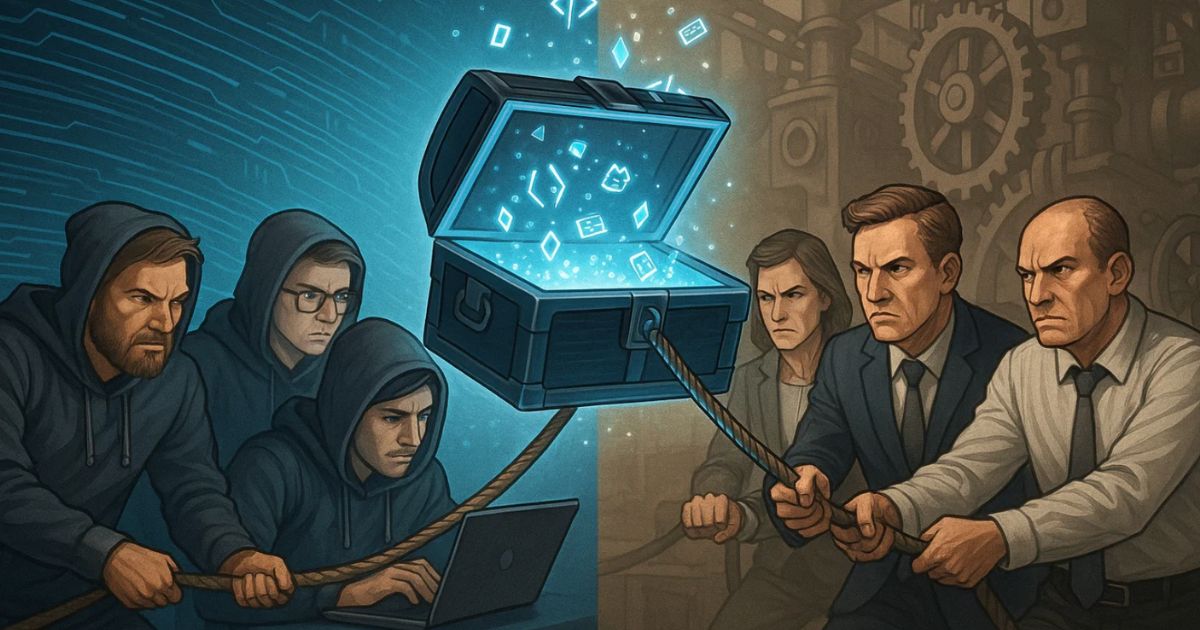Abstract
In April 2025, the Court of Brescia addressed a case that could affect anyone outsourcing the development of custom digital solutions. Two companies – a client and a developer – clashed over the ownership of the source code of industrial software used for operating metal pressing machines. The client company claimed ownership of the software, while the developer asserted exclusive rights and refused to hand over the source code. This led to a legal dispute touching on core principles of industrial law: copyright, software, know-how, and trade secrets.
Why is source code so important?
Source code is a set of instructions written by programmers in human-readable languages. It’s the foundation from which executable code is generated—the version a computer can understand and run. While executable code can only be used, the source code can be modified, adapted, and evolved, making it the true “heart” of the software.
Owning the source code allows a company to modify the program at any time. Not owning it means total dependence on the developer, posing a real risk of operational disruption in case of a fallout.
In complex industrial contexts, such as metal stamping, software is not just a management tool—it’s the brain of the entire system. It controls every phase of production, from applied pressure to the sequence of operations. Often, this code is the result of extensive customization, tailored to specific client or machine needs. In short, it represents technological know-how in informational form, which is hard to replicate without years of experience and testing.
For this reason, source code holds significant commercial value. Whoever holds it can duplicate, reuse, offer variants to clients, or worse, intervene on third-party machinery via parallel support services. It’s a competitive asset—and a potential tool for unfair competition if misused.
Moreover, source code can be legally protected under copyright law as an intellectual work and, in certain cases, as a trade secret if proper legal and security measures are in place. Proper management of source code is key to safeguarding business innovation.
Who owns the source code?
One of the key aspects of the Brescia court’s decision concerns ownership of commissioned software. Simply put, the judge ruled that when a company entrusts another entity—a supplier, consultant, or freelancer—with software development, the final product belongs to the client unless otherwise agreed in writing.
This decision is grounded in Article 12-bis of the Italian Copyright Law (Law No. 633/1941), which states that the employer owns the economic rights of works created by employees. The judge extended this principle by analogy to relationships between companies, even if the developer is an external party, provided they act on assignment and under the client’s direction.
This means that a contract does not need to explicitly mention “transfer of rights”: if the development is clearly part of a commissioned relationship, the economic rights—such as use, modification, and distribution—automatically belong to the client. This is a form of original acquisition, regardless of whether separate payment for ownership is made.
In this case, the judge also valued two non-disclosure agreements from 2009 and 2019, stating that not only the software but also the technical and commercial know-how generated during the collaboration remained the client’s property. These agreements were pivotal in determining the parties’ intentions and confirmed that no exclusive rights were intended for the developer.
This ruling is crucial for businesses. It shows that in the absence of clear contracts, the law protects the client, granting exclusive rights to use and manage commissioned software. Nevertheless, it is always advisable to clarify intellectual property ownership, what the fee includes, and how to manage source code and future updates.
Trade secrets and know-how: an invisible but valuable asset
The ruling also addressed another critical issue: protecting trade secrets and technical know-how. In particular, the client accused the developer of unauthorized use of highly customized technical drawings used in manufacturing industrial presses.
Legally, trade secrets are defined as confidential information with three key features:
- secrecy – they must not be easily accessible to outsiders;
- economic value – they must give a competitive edge to the holder;
- effective protection – they must be secured through appropriate measures, such as NDAs or security systems.
In this case, the technical drawings fit this definition perfectly. They were not generic or standardized materials but tailored designs for specific production needs. The court recognized these documents as a strategic informational asset, built on years of experience, research, and investment. The confidentiality agreements signed by both parties, which explicitly prohibited disclosure or reuse, were given significant weight.
What makes this case especially relevant is the court’s recognition that the competitor’s misuse of these materials constitutes parasitic competition. In other words, instead of investing in its own R&D, the defendant exploited someone else’s experience to gain a competitive advantage—even targeting the same clients. This behavior was deemed unlawful and damaging to both fair competition and intellectual property rights.
For many companies, this section of the ruling is a wake-up call. Protecting know-how isn’t just a duty—it’s an essential investment to prevent information leaks and commercial abuse
How to truly protect software and corporate know-how
Writing software creates value. But commissioning, investing in, and integrating that software into production processes creates a business. And the business must be protected from the start.
The Court of Brescia made it clear: source code developed on assignment belongs to the client, unless otherwise agreed. There’s no room for ambiguity. If software is designed, requested, and paid for to integrate into an industrial process, it belongs to the one who commissioned its creation.
But the real strength of this ruling lies not just in the outcome. It’s in reminding us that protection starts with contracts—not courts.
Any company commissioning software or a tech project must make a conscious choice: do they want to own it or just host it? Only well-drafted and clear agreements on ownership, licenses, code access, and trade secrets can guarantee independence and freedom—even after collaborations end.
The advice, therefore, is simple: those who create value must equip themselves with the tools to preserve it. And the right leverage is not (only) technological. It is legal.
© Canella Camaiora S.t.A. S.r.l. - Tutti i diritti riservati.
Data di pubblicazione: 24 Luglio 2025
È consentita la riproduzione testuale dell’articolo, anche a fini commerciali, nei limiti del 15% della sua totalità a condizione che venga indicata chiaramente la fonte. In caso di riproduzione online, deve essere inserito un link all’articolo originale. La riproduzione o la parafrasi non autorizzata e senza indicazione della fonte sarà perseguita legalmente.

Margherita Manca
Avvocato presso lo Studio Legale Canella Camaiora, iscritta all’Ordine degli Avvocati di Milano, si occupa di diritto industriale.
